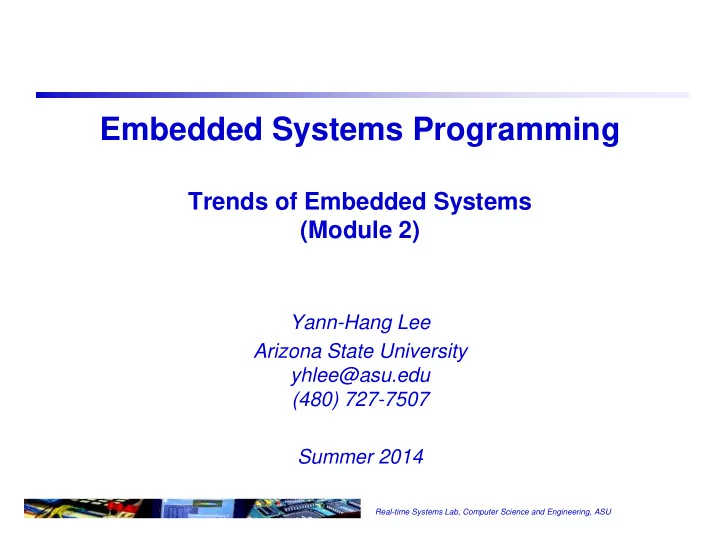

Embedded Systems Programming Trends of Embedded Systems (Module 2) Yann-Hang Lee Arizona State University yhlee@asu.edu (480) 727-7507 Summer 2014 Real-time Systems Lab, Computer Science and Engineering, ASU
Trends of RT Embedded Systems Applications Wide-spreading, distributed, connected, and heterogeneous Mission and safety critical High-end consumer products cell phone, HDTV, home network, PDA, GPS, appliances Quality of the products portable/reusable, reliable/dependable, interoperable, predictable (schedulable), and secured Software extensive A new S-class Mercedes-Benz over 20 million lines of code nearly as many ECUs as the new Airbus A380 (excluding the plane's in-flight entertainment system). 1 Real-time Systems Lab, Computer Science and Engineering, ASU
Software Complexity Software in Smartphones = apps + android + Linux Linux kernel: Language Code Comment Blank Percentage C 15,213,100 3,277,849 2,919,083 94.5% Assembly 474,013 99,107 77,428 2.9% C++ 238,689 107,606 49,138 1.7% XML 85,470 520 7,079 0.4% Make 39,575 11,901 10,859 0.3% Totals 16,086,836 3,504,100 3,070,580 Android: Language Code Comment Blank Percentage C 4,790,691 1,541,950 1,021,643 42.5% C++ 2,922,477 896,141 624,506 25.7% Java 1,530,288 770,935 321,929 15.2% HTML 955,041 51,284 220,949 7.1% (Analyses from XML 524,855 75,396 34,453 3.7% http://www.ohloh.net/) Totals 11,431,145 3,546,030 2,333,226 2 Real-time Systems Lab, Computer Science and Engineering, ASU
Building Embedded Systems Advances in general-purpose computers PCs are powerful, cheap, and versatile Information processing is ubiquitous Thanks for the growth in productivity The design gaps 1,000 Process technology 2x/18 months HW gap 100 Hardware design 1.6x/18 months SW gap 10 Software design 2x/5 years (International Technology Roadmap for 1 0 3 6 9 12 15 Semiconductors, 2011) 3 Real-time Systems Lab, Computer Science and Engineering, ASU
Embedded Software Characteristics Concurrent, time dependent, and device/environment dependent Embedded software development 80% programs in embedded system is with C/C++ and 15% in assembly the same thing that has been done more than 30 years (Ada?) Software complexities inherent and cannot be eliminated, i.e. algorithm, concurrency, etc. accidental (due to technology or methods used), i.e. memory leaks What can we do? abstraction (e.g. high-level languages, modeling) automation (e.g. compiler, code generation) 4 Real-time Systems Lab, Computer Science and Engineering, ASU
Design for Performance and Predictability A system vs. a piece of code Computer science is about abstraction, but resource is needed to run any piece of code model O(n), if (unlikely(!timer)) return -EINVAL; O(n 2 )… abstract Benchmarking and profiling algorithm object data measurement and interpretation data structure resource usage and hot spots library compiler A good understanding on operating system what hardware and software are doing instruction set together space and time tradeoff CPU IO & Bus memory compiler optimization physical time/cycle signal 5 Real-time Systems Lab, Computer Science and Engineering, ASU
Embedded Software Coding Practices High-confidence software is difficult to validate Risk of failure is very high Software errors are systematic, not random. (i.e. predictable and expected.) Case study in LLNL: 200 KLOC C/C++ program 285 defects found using Klocwork, 56 critical (null pointer dereferences, buffer overruns) 14 severe (use of freed memory) 193 errors (leaks, uninitialized variables) and 22 other warnings Bugs found by Coverity Scan (a source code analyzer) linux 2.6 pHp 5.3 postgreSQl 9.1 Lines of code scanned 6,849,378 537,871 1,105,634 Defect Density (as of 12/31/11) 0.62 0.2 0.21 Number of outstanding defects (as of 12/31/11) 4,261 97 233 Number of defects fixed in 2011 1,283 210 78 Number of outstanding defects (as of 1/1/11) 3,457 14 247 (Coverity Scan: 2011 Open Source Integrity Report) 6 Real-time Systems Lab, Computer Science and Engineering, ASU
Coding Standards Two approaches Use coding standards to streamline development Use advanced static-analysis tools to find flaws early MISRA-C/C++: (Motor Industry Software Reliability Association) Misra C – first introduced in 1998, revised in 2004 and 2012 143 rules checkable using static code analysis makes development as predictable as possible, across projects or pieces of code, without errors of interpretation Misra C++ in 2008 (mostly derived from JSF rules): 228 rules Holzmann’s “Power of Ten” and JPL coding standard Examples: check return value of non-void functions name convention – dump_data_to_file() no compilation warnings no errors or warnings resulting from static code analyzers 7 Real-time Systems Lab, Computer Science and Engineering, ASU
Supplementary Slides Real-time Systems Lab, Computer Science and Engineering, ASU
The Power of Ten 1. Restrict to simple control flow 7. Check the return value of constructs. non-void functions, and check the validity of function 2. Give all loops a fixed upper- parameters. bound. 8. Limit the use of the 3. Do not use dynamic memory preprocessor to file inclusion allocation after initialization. and simple macros. 4. Limit functions to no more 9. Limit the use of pointers. Use than 60 lines of text. no more than two levels of 5. Use minimally two assertions dereferencing per expression. per function on average. 10. Compile with all warnings 6. Declare data objects at the enabled, and use one or more smallest possible level of source code analyzers. scope. Real-time Systems Lab, Computer Science and Engineering, ASU 9
Recommend
More recommend